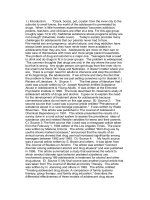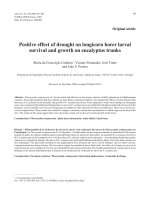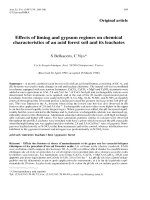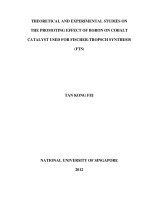Effect of sulphur and boron nutrition on chemical properties of soil after harvest of soybean
Bạn đang xem bản rút gọn của tài liệu. Xem và tải ngay bản đầy đủ của tài liệu tại đây (187.59 KB, 5 trang )
Int.J.Curr.Microbiol.App.Sci (2019) 8(4): 485-489
International Journal of Current Microbiology and Applied Sciences
ISSN: 2319-7706 Volume 8 Number 04 (2019)
Journal homepage:
Original Research Article
/>
Effect of Sulphur and Boron Nutrition on Chemical Properties of Soil after
Harvest of Soybean
S. Ravi1*, R.L. Jadhav2, M.V. Ravi1 and Anand Naik1
1
Departtment of Soil Science and Agricultural Chemistry, KVK, Bidar,
UAS, Raichur, Karnataka, India
2
Department of Agronomy, KVK, Bidar, UAS, Raichur, Karnataka, India
*Corresponding author
ABSTRACT
Keywords
Soil, Available
nutrients, pH,
Organic carbon,
Sulphur, Boron,
Soybean
Article Info
Accepted:
07 March 2019
Available Online:
10 April 2019
An experiment was carried out during Kharif 2014 and 2015 at Krishi Vigyana Kendra
(KVK), Bidar, University of Agricultural Sciences, Raichur, Karnataka, India to assess the
sulphur and born nutrition on chemical properties of soil after harvest of soybean under
rainfed situation of Northern Karnataka. Results revealed that, among different rate of
sulphur and boron application along with recommended dose of fertilizer was significantly
not differed with respect to pH, electrical conductivity and organic carbon content in soil
after harvest of soybean. Further, Application of recommended dose of fertilizer + 12 kg
ZnSO4/ha + 30 kg Sulphur/ha +1.0 kg Boron/ha recorded significantly (p=0.05) higher
available nitrogen (283.5 kg/ha), phosphorus (30.5 kg/ha), potassium (407.5 kg/ha),
sulphur (22.82 kg/ha) and boron (0.44 ppm) in soil after harvest of soybean and which was
on par with the application of recommended dose of fertilizer + 12 kg ZnSO 4/ha + 30 kg
Sulphur/ha +1.5 kg Boron/ha (21.5 q/ha) compared to other treatments. It can be
concluded that, Application of recommended dose of fertilizer (40:80:25 kg NPK/ha) + 12
kg ZnSO4/ha + 30 kg Sulphur/ha +1.0 kg Boron/ha may increases the soil available
nutrients status after harvest of soybean under Northern Karnataka.
production was 12.28 m t with productivity
level of 1.21t per ha, though the crop has
potential productivity of nearly 2,500 – 3,000
kg per ha (Anon. 2016). Sulphur is involved
in synthesis of fatty acid and also increased
protein quality through the synthesis of
certain sulphur containing amino acid such as
cystine, cystein and methionine (Havlin et al.,
1999). Boron deficiency occurs in highly
leached sandy soils, acidic soils and soils low
in organic matter and it plays an important
role in nodulation, flowering, pollen
Introduction
Recently Soybean [Glycine max (L.) Merrill]
is being cultivated as an oilseed crop in India
and it is recognized as “Golden Bean” due to
its high nutritional value such as high quality
protein (40-45 %), oil (18-20 %), mineral
nutrients like calcium, iron and glycine. Apart
from these, it is a good source of isoflavone
which helps in preventing heart disease,
cancer and HIVs. In India, the area under
soybean cultivation was 10.18 m ha and the
485
Int.J.Curr.Microbiol.App.Sci (2019) 8(4): 485-489
germination, fruiting, seed setting and
synthesis of protein and oil (Malewar et al.,
2001).
Boron/ha, T6: RDF (40:85:25 kg NPK/ha) +
12 kg ZnSO4/ha+30 kg Sulphur/ha + 0.5 kg
Boron/ha, T7: RDF + 12 kg ZnSO4/ha+30 kg
Sulphur/ha + 1.0 kg Boron/ha, T8: RDF + 12
kg ZnSO4/ha+30 kg Sulphur/ha + 1.5 kg
Boron/ha.
Bidar District of Karnataka (India) is
dominated by red lateritic and medium to
deep black soils and these soils are poor in
soil fertility due to deficiency of secondary
and micronutrients. Soybean is one of the
important oil seed crop and it is being grown
in an area of 95,000 ha with a production of
33,250 thousand tonnes with an average
productivity of 725 kg/ha. Since, the yields
are low as compared to state average (950
Kg/ha). Intensive cropping, indiscriminate use
of fertilizers and limited use of organic matter
are the reasons for occurrence of sulphur and
boron deficiency in the region which limits
soil fertility and soybean yield. However,
very meager information is available on
response of soybean to sulphur and boron
nutrition on chemical properties of soil after
harvest of crop. Hence a field experiment was
conducted to investigate the effect of sulphur
and boron nutrition on chemical properties of
soil after harvest of soybean in Northern
Karnataka.
The experiment was laid out in randomized
complete block design with three replications.
Soybean variety JS 335 was grown at a row
spacing of 45 cm. Crop received
recommended dose of nutrients @ 40:80:25:
kg N:P2O5:K2O per ha through urea, diammonium phosphate and muriate of potash,
respectively. Sulphur and boron were applied
as per treatment details through gypsum (18
% S) and borax (11 % B), respectively.
Soybean seed were inoculated with
Bradyrhizobium japonicum culture @ 5 g per
kg seed. The rainfall received during kharif
2014 and 2015 was 800 mm and 950 mm,
respectively. Other crop management
practices
were
performed
as
per
recommended package of practices. Available
nitrogen in soil was determined by alkaline
permanganate method as outlined by Subbiah
and Asija (1959).
Available phosphorus in soil was determined
by Bray’s method as outlined by Jackson
(1967). Available potassium in soil was
determined by neutral normal ammonium
acetate solution using flame photometer as
outlined by Jackson (1967). The soil available
sulphur was determined by turbidimetric
method as outlined by Chesnin and Yien,
1950). The soil available boron was
determined by Azomethine H method
(Jackson, 1967). MSTAT was used for
statistical analysis of data and means were
separated using critical difference (CD) at
p=0.05. The data on weeds were transformed
by square root transformation before being
subjected to ANOVA (Gomez and Gomez,
1984).
Materials and Methods
An experiment was carried out during Kharif
2014 and 2015 at Krishi Vigyana Kendra
(KVK), Bidar, University of Agricultural
Sciences, Raichur, Karnataka, India. The soil
of the experimental field was clay loam,
slightly saline (pH 8.32), high in organic
carbon (0.53 %), available nitrogen (285.0 kg
N/ha), phosphorus (30 kg P2O5/ha), potassium
(416 kg K2O/ha), sulphur (8.3 ppm) and
boron (0.46 ppm).
The experiment was comprises of eight
treatments viz., T1: Absolute Control, T2: RPP
(40:85:25 kg NPK + 12 kg ZnSO4+20 kg
Sulphur/ha), T3: RPP + 0.5 kg Boron/ha, T4:
RPP + 1.0 kg Boron/ha, T5: RPP + 1.5 kg
486
Int.J.Curr.Microbiol.App.Sci (2019) 8(4): 485-489
ZnSO4/ha + 30 kg Sulphur/ha +1.0 kg
Boron/ha (22.16 kg/ha) and which was onpar
with the application of recommended dose of
fertilizer + 12 kg ZnSO4/ha + 30 kg
Sulphur/ha +0.5 kg Boron/ha (281.5, 28.5 and
383.0 kg/ha, respectively) compared to other
treatments. The control treatment recorded
significantly lower available nutrients in soil.
These results are conformity with the findings
of Meena et al., (2011).
Results and Discussion
Effect on chemical properties of soil
The data on chemical properties of soil is
presented in Table 1. Results revealed that,
among different rate of sulphur and boron
application along with recommended dose of
fertilizer was significantly not differed with
respect to pH, electrical conductivity (EC)
and organic carbon (OC) content in soil after
harvest of soybean.
Similarly, Sulphur availability in soil after
harvest of crop was increased with increasing
levels of sulphur application. Maximum
available sulphur in soil (22.82 kg/ha) being
associated
with
the
application
of
recommended dose of fertilizer + 12 kg
ZnSO4/ha + 30 kg Sulphur/ha +1.0 kg
Boron/ha and which was on par with the
application of recommended dose of fertilizer
+ 12 kg ZnSO4/ha + 30 kg Sulphur/ha +1.5 kg
Boron/ha (17.67 kg/ha) compared to other
treatments. The control treatment recorded the
lowest soil available sulphur.
Effect on soil available nutrients after
harvest of soybean
Available nitrogen, phosphorus and potassium
in soil was significantly (p=0.05) increased
with different rate of application of sulphur
and boron level (Table 2 and 3). Maximum
availability of nitrogen (283.5 kg/ha),
phosphorus (30.5 kg/ha) and potassium (407.5
kg/ha) in soil after harvest of soybean was
observed in the treatment with the application
of recommended dose of fertilizer + 12 kg
Table.1 Effect of sulphur and boron nutrition on chemical properties of soil after harvest of
soybean
Treatments
T1: Absolute control
T2: RPP (40:80:25 kg
NPK/ha + 12 kg ZnSO4/ha +
20 kg Sulphur/ha)
T3: RPP + 0.5 kg Boron/ha
T4: RPP + 1.0 kg Boron/ha
T5: RPP + 1.5 kg Boron/ha
T6: RDF (40:80:25 kg
NPK/ha) + 12 kg ZnSO4/ha
+ 30 kg Sulphur/ha + 0.5 kg
Boron/ha
T7: RDF + 12 kg ZnSO4/ha
+ 30 kg Sulphur/ha +1.0 kg
Boron/ha
T8: RDF + 12 kg ZnSO4/ha
+ 30 kg Sulphur/ha +1.5 kg
Boron/ha
C.D.(P=0.05)
EC (dSm-1)
2015
Pooled
0.23
0.24
0.27
0.29
2014
8.33
8.35
pH
2015
8.27
8.30
Pooled
8.30
8.32
2014
0.25
0.30
8.39
8.39
8.38
8.38
8.35
8.37
8.33
8.38
8.37
8.38
8.35
8.38
0.31
0.32
0.33
0.33
0.32
0.34
0.30
0.35
0.31
0.33
0.32
0.34
0.58
0.57
0.59
0.56
0.57
0.55
0.56
0.57
0.57
0.56
0.58
0.57
8.42
8.40
8.41
0.36
0.38
0.37
0.55
0.54
0.55
8.39
8.38
8.39
0.35
0.36
0.36
0.56
0.58
0.57
NS
NS
NS
0.02
0.03
0.03
NS
NS
NS
487
2014
0.53
0.58
OC (%)
2015
Pooled
0.51
0.52
0.53
0.56
Int.J.Curr.Microbiol.App.Sci (2019) 8(4): 485-489
Table.2 Effect of sulphur and boron nutrition on soil available nutrient status after harvest of
soybean
Treatments
T1: Absolute control
T2: RPP (40:80:25 kg NPK/ha +
12 kg ZnSO4/ha + 20 kg
Sulphur/ha)
T3: RPP + 0.5 kg Boron/ha
T4: RPP + 1.0 kg Boron/ha
T5: RPP + 1.5 kg Boron/ha
T6: RDF (40:80:25 kg NPK/ha) +
12 kg ZnSO4/ha + 30 kg
Sulphur/ha + 0.5 kg Boron/ha
T7: RDF + 12 kg ZnSO4/ha + 30
kg Sulphur/ha +1.0 kg Boron/ha
T8: RDF + 12 kg ZnSO4/ha + 30
kg Sulphur/ha +1.5 kg Boron/ha
C.D.(P=0.05)
Nitrogen (kg/ha)
2014
2015
Pooled
229
244
226.5
242
238
240.0
P2O5 (kg/ha)
2014
2015
Pooled
20
21
20.5
26
24
25.0
K2O (kg/ha)
2014
2015
Pooled
358
351
354.5
365
367
366.0
265
274
271
284
254
263
263
279
259.5
268.5
267.0
281.5
22
25
23
28
21
26
25
29
21.5
25.5
24.0
28.5
370
376
381
384
371
373
370
382
370.5
374.5
375.5
383.0
288
279
283.5
30
31
30.5
405
410
407.5
280
271
275.5
27
26
26.5
395
397
396.0
13.44
18.44
15.94
2.30
3.25
2.77
10.73
13.87
12.30
Table.3 Effect of sulphur and boron nutrition on soil available nutrient status after harvest of
soybean
Treatments
T1: Absolute control
T2: RPP (40:80:25 kg NPK/ha + 12
kg ZnSO4/ha + 20 kg Sulphur/ha)
T3: RPP + 0.5 kg Boron/ha
T4: RPP + 1.0 kg Boron/ha
T5: RPP + 1.5 kg Boron/ha
T6: RDF (40:80:25 kg NPK/ha) + 12
kg ZnSO4/ha + 30 kg Sulphur/ha +
0.5 kg Boron/ha
T7: RDF + 12 kg ZnSO4/ha + 30 kg
Sulphur/ha +1.0 kg Boron/ha
T8: RDF + 12 kg ZnSO4/ha + 30 kg
Sulphur/ha +1.5 kg Boron/ha
C.D.(P=0.05)
Sulphur (kg/ha)
2014
2015
Pooled
8.15
8.10
8.13
10.66
10.13
10.40
2014
0.39
0.45
10.19
14.23
16.15
16.95
10.00
14.54
17.30
17.55
10.09
14.38
16.72
17.25
0.39
0.40
0.44
0.42
0.38
0.41
0.42
0.44
0.39
0.41
0.43
0.43
22.50
23.15
22.82
0.43
0.45
0.44
17.57
17.77
17.67
0.47
0.48
0.48
2.25
2.73
2.49
0.02
0.03
0.02
The above results revealed that sulphur doses
increased sulphur availability in soil after
harvest of soybean. Similar findings are also
reported by Ganeshamurthy (1996) who
reported that application of sulphur
significantly increased the sulphur availability
in soil after the harvest of soybean. The
Boron (ppm)
2015
Pooled
0.37
0.38
0.44
0.44
highest boron availability in soil was achieved
by the application of recommended dose of
fertilizer + 12 kg ZnSO4/ha + 30 kg
Sulphur/ha +1.5 kg Boron/ha (0.48 ppm) and
which was closely followed by the application
of recommended dose of fertilizer + 12 kg
ZnSO4/ha + 30 kg Sulphur/ha +1.0 kg
488
Int.J.Curr.Microbiol.App.Sci (2019) 8(4): 485-489
Boron/ha (0.44 ppm) compared to other
treatments. The lowest soil available boron
was observed in control plot. Similar results
are also reported by Saxena and Nainwal
(2010) and Singh, et al., (2013).
fertilizers. Prentice hall of India, 6th
ed., pp 220-27 and 319-346.
Jackson, M.L., 1967, Soil Chemical Analysis.
Prentice Hall of India Pvt. Ltd., New
Delhi, pp. 183-192.
Malewar G V, Kate S D, Waiker S L and
Ismail S. 2001. Interaction effect of
zinc and boron on yield, nutrient
uptake and quality of mustard
(Brassica juncia L.) on a typic
Haplustert. Journal of Indian Society
of Soil Science 49: 763-5.
Meena D S, Ram B and Tetarwal J P. 2011.
Productivity, quality and profitability
of soybean (Glycine max L.) as
influenced by sulphur and boron
nutrition. Soybean Research 9: 103108.
Saxena S C and Nainwal R C. 2010. Effect of
sulphur and boron nutrition on yield,
yield attributes and economics of
soybean. Soybean Research 8: 7-12.
Singh, A. K., Singh, C. S. and Yadava, J. P.,
2013, Response of Soybean to Sulphur
and Boron Nutrition in Acid Upland
Soils of Jharkhand. Soybean Research
11(2): 27-34
Subbiah, B.V. and Asija, C.L., 1959, A rapid
procedure for estimation of available
nitrogen in soils. Curr. Sci., 25:259260
In conclusion, results indicated that,
application of recommended dose of fertilizer
+ 12 kg ZnSO4/ha + 30 kg Sulphur/ha +1.0 kg
Boron/ha may enhances the soil available
nutrient status and proved the improvement of
soil fertility status in northern dry zone of
Karnataka.
References
Anonymous. 2016. Director‟s Report and
Summary Tables of Experiments
(2015- 2016), All India Coordinated
Research Project on Soybean, Indore.
Chesnin, L and Yien, C.N., 1950. Proceedings
of Soil Science Society of America.
15:149
Ganeshamurthy A N. 1996. Effect of sulphur
application on seed and oil yield of
Soybean. Journal of the Indian Society
of Soil Science 44(2): 290-4.
Gomez, K.A. and A.A. Gomez, (1984).
Statistical procedures for agricultural
research (2 ed.). John wiley and sons,
NewYork, 680p
Havlin L J, Beaton D J, Tisdale L S and
Nelson L W. 1999. Soil fertility and
How to cite this article:
Ravi, S., R.L. Jadhav, M.V. Ravi and Anand Naik. 2019. Effect of Sulphur and Boron Nutrition
on Chemical Properties of Soil after Harvest of Soybean. Int.J.Curr.Microbiol.App.Sci. 8(04):
485-489. doi: />
489









